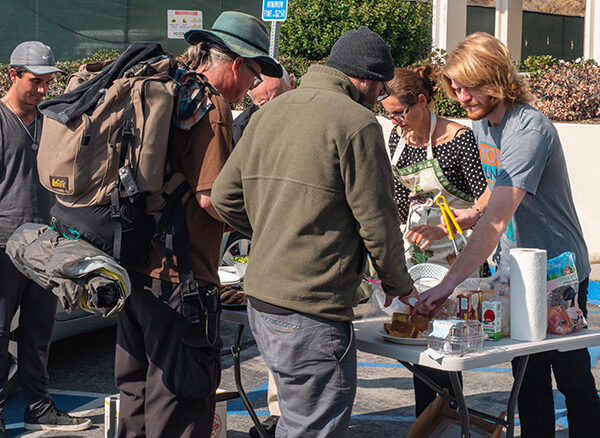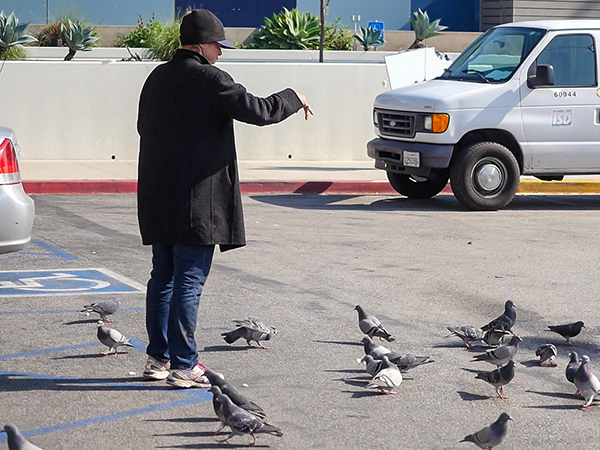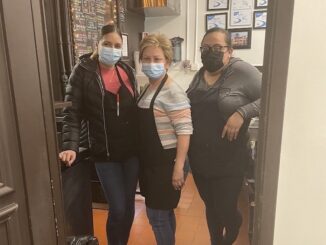
William Junior, 62, smiled as he gulped down one of Sabrina Petty’s homemade cupcakes.
Petty, a member of The People Concern’s Malibu Outreach Team, often delivers food to the homeless clients she serves with partner Devan Liddle. The duo were picking Junior up outside of Ralphs in Malibu Colony Plaza to take him to the Malibu Library. Junior has been homeless for four and a half years.
The Malibu Outreach Team callto check up on their clients and provide them with rides and services as needed. However, they are only one part of the bigger plan Malibu officials and outreach workers created to address the needs of the homeless.
The City of Malibu adopted its Homelessness Strategic Plan in June 2018. The plan established a housing-priority goal but also allotted resources for the homeless population by providing meals and services organized by various social work groups, such as The People Concern, St. Joseph Center and the Malibu Labor Exchange.
However, due to the Woolsey Fire and government regulations, some plans set into action last year have either been put on standstill or are being reworked, including the homeless dinners at the old courthouse.
“We were actually on a pretty good path,” said Alexander Gittinger, program manager for Malibu/Palisades outreach for The People Concern and a contributor to the plan. “But then the fire happened, and it just threw everything out of the loop for a few months. So, we’re kind of in the process of recuperating everything we had.”
As the plan trudges on after the fire to secure housing vouchers for some of Malibu’s homeless, the more immediate services allow some respite from the conditions of homelessness.
The plan
The City of Malibu created its Homelessness Strategic Plan in order to develop ways to better assist its homeless population. Various invested organizations had a say in the plan’s creation in order to address a common agenda.
“The goal was to bring together all the people in town because there are quite a few nonprofits in town and church groups who had already been reaching out to the homeless and trying to assist them,” said Susan Duenas, the public safety manager for the City of Malibu. “But we wanted to bring everybody together and have a more coordinated response to assisting homeless individuals.”
Scott Edens, a case manager for St. Joseph’s Center and a contributor to the plan, explained the difficulties that arose.
“Everybody’s got an agenda based off of what their knowledge is,” Edens said. “If you’re looking at building a house, the contractors are going to look at it differently than the homeowner that’s like, ‘Well, I want my bathroom over there,’ only he’s going to think about laying pipe and how that’s going to be and what supplies he’s going to need. So, you’ve got all these different people with different agendas with a different point of view.”
In the end, the plan made housing a priority, while also addressing the more immediate needs of the homeless population through the distribution of meals, supplies and clothing, and access to medical check-ups.
A working group meets monthly to review successes and roadblocks of the plan to figure out what aspects of the homeless situation they need to address next. Edens, who was once homeless himself, thinks these check-ins are crucial.
“I give the city a lot of credit for holding the plan and holding these meetings,” Edens said, “because the water’s rising and it’s not going to stop rising. You got to figure out a way to deal with it and start averting some of that water before we drown in it.”
Oscar Mondragon, director of the Malibu Labor Exchange, supported the effort of the plan and the outreach groups involved.
“They’ve been successful,” Mondragon said. “They’ve been placing people in homes and in their own rooms. Yeah, they have. So, the effort is worth it.”
The Woolsey Fire
The Homelessness Strategic Plan hit a major roadblock in Fall 2018 with the onslaught of the Woolsey Fire.
“Once the fire came, Malibu came to a dead stop,” Edens said.
Allies in the Los Angeles County Sheriff’s Department escorted Edens, his team, and the Malibu Outreach Team past fire lines to look for and extract the homeless they had come to know.
As for the plan, Gittinger said he was disappointed by the apparent backtracking that occurred due to the Woolsey Fire.
One service that was affected was the homeless dinners at the courthouse that came to a standstill.
“That was some heavy lifting,” Gittinger said, “because we had to deal with all kinds of red tape from the county, and yet we overcame and it was done. But then the fires and then FEMA moved in, and then you know what happened, so — and now statutes have expired and this, that and the other, so now we have more red tape.”
Gittinger also explained the demise of another project that was to ensure safe parking for the homeless in the Malibu Seafood parking lot.
“That was very well on its way,” Gittinger said. “Well, that place burned down, so back to square one on that one.”
Gittinger said he has not lost hope in the future success of his and other outreach workers’ efforts, though.
“There are a couple of things that were in the making that has stalled,” Gittinger said. “What has not stalled is the advocacy work that I’m part of.”
New vouchers
Due to the fire, the Los Angeles Homeless Services Authority (LAHSA) allocated funds for 20 Section 8 vouchers to be made available to Malibu, Liddle said.
Public housing agencies distribute Section 8 vouchers, which allow the receiver to determine where he or she lives, according to the U.S. Department of Housing and Urban Development. The vouchers are designed to allow low-income, elderly, and/or disabled people to move into safer, better housing.
However, Petty explained that getting a voucher does not equal acquiring secured housing.
“It’s not just, ‘OK, you have a voucher, now you get an apartment,’” Petty said. “It’s you have to meet the landlord. The landlord has to like you and think you’re a good fit for that unit. You don’t just automatically get into an apartment because you have a Section 8 voucher.”
In order to qualify for these vouchers, candidates have to show that they are in the right mental state or are on the right medications so as not to lose the housing that they would acquire through the vouchers. The outreach workers also check for a California ID, a Social Security card and a source of income and/or welfare.
Due to the lack of affordable housing in Malibu, receivers of the vouchers must turn instead to areas of Los Angeles like Koreatown or to surrounding cities and counties.
Despite the underlying difficulties of securing housing, Junior maintains strong in his conviction to one day attain this “better” living.
“I won’t be out here too much longer because this ain’t my type of lifestyle, you know,” Junior said. “So, I hopefully have my own place and have my Section 8, and I’ll be safe. I won’t be out here no more.”

Services for the here and now
While the homeless await their chances at housing vouchers, they have needs for food, clothing and medical attention.
The Malibu Outreach Team regularly visits the homeless throughout Malibu. They pass out sandwiches and extra clothing while checking on their clients. They bring doctors to them on Thursdays to provide them with medical examinations (physical and mental).
The Community Assistance and Resource Team (CART) hosts the homeless lunches and dinners in front of the courthouse, at Zuma Beach and at Malibu United Methodist Church. Laundry Love brings the homeless to laundromats, pays for their loads and even folds their clothes if help is needed.
Gittinger said it’s all about listening to what the homeless need and attempting to make them feel as if they are still in control of their lives instead of simply telling them what to do.
“Shouldn’t we ask the people on the street what they need, what can help them?” Gittinger said.
Mark Hewitt, 68 and homeless since 2008, commented on the change of services available in Malibu since becoming homeless.
“When I first came there was nothing, and now we got some people that are coming by regularly a couple of times a week bringing us food,” Hewitt said. “I don’t think anybody really realized that because Malibu is the home of multi-millionaires that live on the beach and frolic around in the sun, they didn’t realize that there was really a homeless population here. And then once they found out, then people started trying to help.”
However, 20-year Malibu resident William Winokur does not believe in giving away food for free and suggested an alternative to the free meals that some organizations provide.
“Give me an hour of cleaning up this area, and then I will give you a meal,” Winokur said. “And then we can take that as far as we want. Give me four hours and I will give you two meals and money. Give me eight hours and — I really believe that it starts to restore dignity when someone works to earn, whether it’s a meal, a place to sleep, money, too.”
Junior shares a similar mentality of giving back for the help he receives.
“They’re doing the best that they can,” Junior said, acknowledging the Malibu Outreach Team. “So, all us homeless out here, we got to do something, too, to help and make it better, and that’s what I do. So when they tell me to do something and go take care of this and that, I go out there and handle my business. And I’m doing pretty good. I’m making some pretty good progress.”
Amongst the services already accounted for, there still may be a service left unprovided for the homeless.
“In LA, they have the LAHSA come and the shower trucks, and they let you take hot showers,” Joshua Crawford, homeless for 11 years, said. “So, that would be nice.”
Pepperdine students and homeless outreach opportunities
Pepperdine students may wonder the relevance of homeless outreach and homelessness awareness in Malibu to their own lives.
“Well, I mean, Jesus was homeless, right?” Hewitt said.
Chase Manson, a junior international studies and political science major, volunteered for the Homeless Count his freshman year. Although he felt as if he were doing a service, Manson did not expect the attitudes of the other volunteers.
“I just remember a woman begging the organization to give her a police escort as she counted homeless people, as she believed she was going to be attacked by several homeless people,” Manson said. “And that to me just unsettled me because I had done previous work with a lot of homeless organizations, and maybe it’s because I’m a male and younger that probably my chances of being attacked are lessened but it did just kind of upset me that her instant thought is ‘I’m going to be attacked by a homeless person.’”
Unlike Manson, Nicole Renfroe, a senior political science major, has not volunteered to work with the homeless while in college but she did in high school at her church.
“We do soup kitchens, as well as trying to basically give them a makeover to be able to send them on job interviews and stuff like that,” Renfroe said.
Both Manson and Renfroe, as well as roughly 79 percent of Pepperdine students in a Pepp Post poll of 53 students, expressed interest in volunteering more with the homeless in Malibu if there were opportunities available.
Jack Kehoe, an integrated marketing communication major and the student coordinator for Pepperdine’s homeless outreach program, outlined some ways in which students could get involved.
Currently, there is a dinner Monday nights from 4 to 6 p.m., lunch at the courthouse Tuesdays and Fridays at 11:30 a.m. and dinner at Zuma beach Wednesdays at 4 p.m.
“So any of those opportunities to serve the homeless in Malibu, and additionally, we can set up any volunteer opportunities on Skid Row or anywhere else in regard to hunger and homelessness,” Kehoe said.
Kehoe gave an insight that echoes those of other outreach workers.
“I think that’s a really difficult thing about homelessness is being dehumanized and not being acknowledged as a human,” Kehoe said. “So just even saying hi to people goes a long way.”
Kaelin Mendez completed the reporting for this story in Jour 241 in Fall 2021 under the supervision of Dr. Christina Littlefield and Dr. Theresa de los Santos. Dr. Littlefield supervised the web version of the story.




